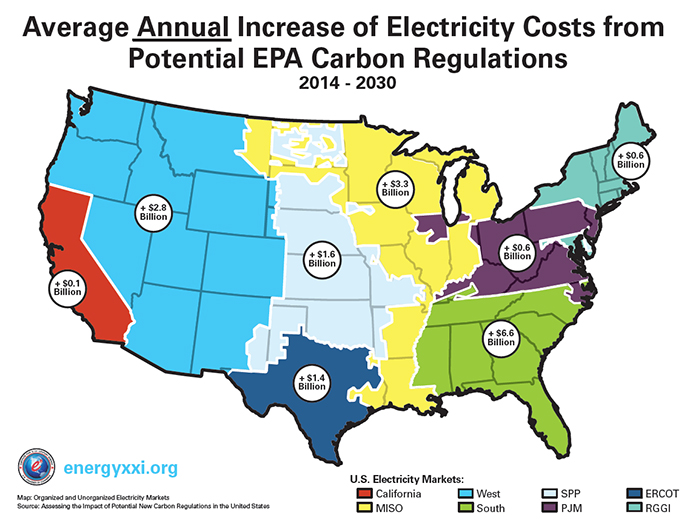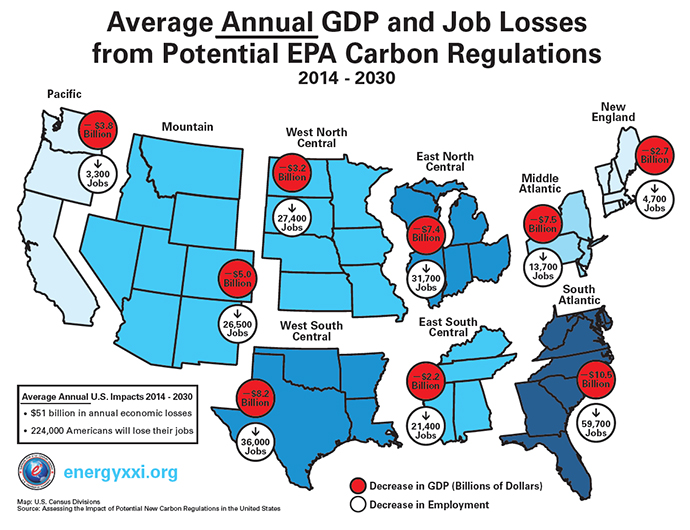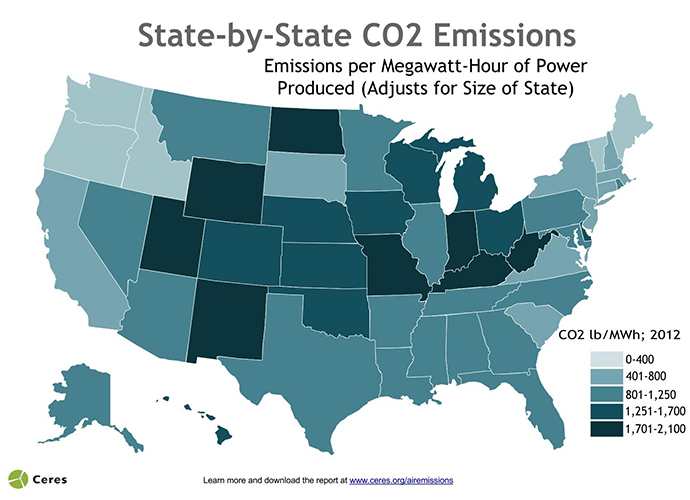Judging from reactions across the country, new carbon pollution guidelines for existing power plants released this week by the US Environmental Protection Agency mean the sky is surely falling.
Or maybe, to cite the late Stevie Ray Vaughan, it’s simply crying. About 1,000 power plants today emit more than two billion tons of carbon dioxide each year, accounting for 40 percent of the total U.S. carbon pollution emissions.
“Although we limit pollutants like mercury, sulfur, and arsenic, currently, there are no limits on carbon pollution from power plants, our nation’s largest source,” said EPA Administrator Gina McCarthy in announcing the proposed guidelines on June 2. “For the sake of our families’ health and our kids’ future, we have a moral obligation to act on climate. When we do, we’ll turn climate risk into business opportunity, we’ll spur innovation and investment, and we’ll build a world-leading clean energy economy.”
By 2030, says the EPA, as each of the 50 states meets carbon emissions goals, the power generation sector will have reduced its carbon pollution by 30 percent over 2005 levels. But many in the business community fear the jobs fallout.
“Today’s regulations issued by EPA add immense cost and regulatory burdens on America’s job creators,” said US Chamber President and CEO Thomas J. Donohue. “They will have a profound effect on the economy, on businesses, and on families.”
The Chamber’s Institute for 21st Century Energy commissioned IHS to put together a report, “Assessing the Impact of Potential New Carbon Regulations in the United States,” that estimates the economic impacts associated with an EPA regulatory regime imposed under Section 111 of the Clean Air Act and based on the Obama Administration’s emissions reduction goals. The analysis found that EPA’s potential new carbon regulations would:
- Lower U.S. Gross Domestic Product (GDP) by $51 billion on average every year through 2030;
- Lead to 224,000 fewer U.S. jobs on average every year through 2030;
- Force U.S. consumers to pay $289 billion more for electricity through 2030;
- Lower total disposable income for U.S. households by $586 billion through 2030.
The EPA begs to differ. Over four decades, said McCarthy, “EPA has cut air pollution by 70 percent and the economy has more than tripled. All while providing the power we need to keep America strong. Climate action doesn’t dull America’s competitive edge — it sharpens it. It spurs ingenuity, innovation, and investment … There’s a reason empty allegations from critics sound like a broken record,” she continued, noting objections to regulations controlling smog and acid rain. “It’s the same tired play from the same special-interest playbook they’ve used for decades.”
The Chamber’s report was released on the same day it also objected to a new EPA/Army Corps of Engineers Clean Water Protection rule.
“Today shows the Chamber never met pollution it didn’t like,” said Jon Devine, a senior attorney with the Water Program at the Natural Resources Defense Council, in reaction to the two volleys from the Chamber. One day later, the NRDC released its own special study of the potential impact of the new EPA guidelines, based on the NRDC’s own Dec. 2012 proposal. The report conducted by ICF International, says the pollution limits “can save American households and business customers $37.4 billion on their electric bills in 2020 while creating more than 274,000 jobs.”
The analysis also highlights similar potential new job creation and electric bill savings in 13 key states: Arkansas, Colorado, Florida, Illinois, Iowa, Michigan, Minnesota, Missouri, Nevada, North Carolina, Ohio, Pennsylvania and Virginia.

Whatever Works for You
“The glue that holds this plan together, and the key to making it work, is that each state’s goal is tailored to its own circumstances,” said McCarthy, “and states have the flexibility to reach their goal in whatever way works best for them.”
But where some see flexibility, others see the minefield of picking favorites. Or, as analysis by Bloomberg New Energy Finance entitled “50 Chefs Stir the Pot” puts it, a recipe for a very weak soup.
“Headlining the regulations are a series of emissions rate (lb/MWh) targets unique to each state,” says the Bloomberg analysis. “And the variation among states is stark: Some states face substantially stiffer reduction targets than others. The wide variation among states is based on the agency’s evaluation of what it calls each state’s emissions ‘framework’: existing fossil generation, zero-carbon generation, energy efficiency potential and the outlook for both coal-plant retirements and low-carbon deployment in the future.”
Intensity-reduction targets range from 72 percent in Washington State to 11 percent in North Dakota. Based on a background briefing from an EPA official, Bloomberg notes that Washington’s high goal “is partly based on the expectation that TransAlta’s 1,460MW Centralia, Wash., coal plant will be decommissioned between 2020 and 2030.” Indiana, the analysis notes, “is an example at the other end of the spectrum. While it was the country’s fifth-highest CO2 emitter in 2012, it was assigned a relatively modest 20 percent reduction goal by EPA. A factor in that target is the state’s limited access to incremental natural gas capacity for power generation relative to other states, an official said.”
While the EPA refers to its “partnership” with states in establishing rules and then meeting goals, Bloomberg points out that “the partnership is hardly voluntary; the Clean Air Act mandates federal-state cooperation on the regulation of pollutants from existing stationary sources … As a result, the joint rulemaking’s outcome could be delayed by legal challenges or weakened by state policy-making inertia.”
In other words, customized standards might result in no standard at all, or at best a convoluted tangle of timelines, goals and requirements. “It will take time (and heavy modeling efforts) to determine exactly what the EPA’s Clean Power Plan means in terms overall reduction targets, implications for state implementation plans, effects on the electric fleet, and power prices,” says the Bloomberg analysis.
But there is still time: States much submit initial plans by June 1, 2016, with options for time extensions to June 2017 or June 2018 if it involves a multi-state approach. EPA will accept comment on the proposal for 120 days after publication in the Federal Register and will hold four public hearings on the proposed Clean Power Plan this summer during the week of July 28 in Denver, Atlanta, Washington, DC (where no power plants exist subject to the guidelines exist) and Pittsburgh.
Proactive Measures
Many regions, utilities and companies, of course, have seen the writing on the wall for some time, and, as McCarthy put it, “already blazed the trail.” She highlighted efforts from Salt Lake City, Utah, and St. Paul, Minn., among others, a well as programs from companies such as Exelon, Entergy, Best Buy and Bank of America. To date, 47 states have utilities that run demand-side energy efficiency programs, 38 have renewable portfolio standards or goals, and 10 have market-based greenhouse gas emissions programs.


The EPA estimates its guidelines will shrink electricity bills by roughly 8 percent by increasing energy efficiency and reducing demand in the electricity system.
“With the new Clean Power Plan, the prospects of doubling US energy productivity have risen tremendously,” said Kateri Callahan, president of the Alliance to Save Energy. “And, as our studies show, the benefits to our country go far beyond the reduction of CO2 — doubling US energy productivity by 2030 could create 1.3 million jobs and pump $325 billion back into the economy.” The group will host on June 9 a webinar co-hosted with the American Council for an Energy-Efficient Economy (ACEEE) that looks more closely at the new rules’ energy efficiency opportunity.
Meanwhile, a new report on U.S. power plant emissions from the country’s top 100 electric power producers shows a downward trend in nitrogen oxides (NOx), sulfur dioxides (SO2), mercury and carbon dioxide (CO2) since 2000, with CO2 emissions decreasing 13 percent between 2008 and 2012. In other words, the industry is already shifting.
“The electric power industry is firmly on the path toward a low carbon energy future, and history shows that it is not only capable of meeting new pollution limits, but that it can do so while keeping our lights on and our economy growing,” said Mindy Lubber, president of Ceres, a nonprofit sustainability advocacy group which helped produce the report. “EPA’s proposed standards will stimulate further investment in low-carbon, low-risk resources like renewable power and energy efficiency.”
CO2 emissions per megawatt-hour of power produced were found to vary close to 20-fold among the states, with Kentucky, Wyoming, West Virginia, Indiana, and North Dakota having the highest CO2 emissions rates, and Idaho, Vermont, Washington, Oregon, and Maine with the lowest CO2 emissions rates.
The report shows that major power companies in the Southeast, Midwest and Southwest regions have all seen declines in CO2 per megawatt-hour produced since 2000, with power producers in the Gulf South and Southeast (Entergy Corporation, Dominion and Southern Company) achieving some of the deepest reductions.
Coal accounted for 39 percent of the power produced by the 100 largest companies in 2012, down from 44 percent in 2011. Roughly 18 percent of the nation’s coal-fired generating fleet (over 58,000 megawatts) has been slated for retirement since 2010. And average utilization of coal plants (how often the plants are run) has dropped from 73 percent in 2008 to 60 percent in 2013. Among other findings:
- Among the 100 largest companies, natural gas use rose from 23 percent of power produced in 2011 to 29 percent in 2012. Across the entire electric sector, natural gas use has increased 60 percent over the past 10 years, reflecting relatively low natural gas prices.
- Among the 100 largest companies in 2012, nuclear accounted for 22 percent of power produced; hydroelectric power 7 percent; non-hydroelectric renewables and other fuel sources 3 and 1 percent, respectively; and oil is negligible. Nuclear power plants account for about 60 percent of zero-carbon-emitting sources in the U.S.
- Across the entire electric sector, renewable energy electricity generation increased 31 percent since 2010 (by more than 50,000 gigawatt hours) even as total electricity generation declined modestly.
- Energy efficiency programs grew to $8.2 billion in 2012, with average costs of 2 to 4 cents per kilowatt hours saved compared with 10 cents for the average retail price of electricity.
“One objective of this report is to help illuminate the complex emissions landscape in this country — the struggle to balance environmental priorities with economic sustainability,” said Chuck Barlow, Entergy’s vice president of environmental strategy and policy. “People want jobs, a strong economy, and clean air and water. Entergy supports all these aspects of American life while maintaining a track record of strong environmental performance. A decade of investments in efficient natural gas and clean, reliable nuclear energy has significantly decreased Entergy’s emissions intensity.”
“Today’s report shows an industry in transition,” said Geraldine A. Smith, general environmental counsel managing director, environment, PSEG Power, when the report was released May 28. “Driven by low natural gas prices and more stringent environmental regulations, CO2 and NOx emissions from the power sector have declined in New Jersey. We at PSEG Power are proud of our progress, and proud to have one of the lowest emitting fleets in the nation thanks in large measure to our nuclear stations. The report underscores nuclear power‘s role in a low-carbon energy future.”
That’s good news for TVA (a top user of coal in the past), whose Watts Bar Nuclear Plant’s Unit 2 reactor remains on schedule to become the nation’s first new nuclear generation of the 21st century. Targeted to begin commercial operation between September 2015 and June 2016, the reactor will be the nation’s first to generate “new” power in nearly two decades, and the first since Watts Bar Unit 1 in 1996. About 3,200 workers are on the Watts Bar 2 project, which will be TVA’s seventh nuclear unit. Watts Bar 2 will add 1,100 megawatts of carbon-free electricity, providing enough energy for approximately 650,000 homes.

Asked by Site Selection in May about the economic development impact of the project, Mike Skaggs, TVA senior vice president for Watts Bar Operations and Construction, said it’s brought thousands of direct and secondary jobs to the area.
“We’ll add an additional 300 full-time jobs — very well paying jobs — and the nuclear plant creates the need for material and services, so that has a positive impact on the area,” he said. Perhaps more meaningful, once complete, the new nuclear power plant “supports a diversified portfolio for TVA. It continues to support us providing a safe, reliable lower cost electricity to the Valley, which in the end stimulates people coming in to look at our area” for locating new manufacturing and other facilities, he said.
“For more than half the states in America, nuclear power plants are their largest source of carbon-free electricity,” said Richard Myers, the Nuclear Energy Institute’s vice president for policy development, planning and supplier programs, on June 2. “For many, it is their dominant source of zero-carbon power. So there’s no question that any serious effort to reduce carbon emissions must acknowledge the need to maintain and expand the use of nuclear energy. We are pleased to see that the proposed rule recognizes nuclear energy’s attributes.”
Yet coal projects with strict controls do continue to make headway. On May 30, the Kansas Department of Health and Environment (KDHE) issued the air quality permit addendum for the proposed 895-MW Coal-Fired Power Plant at the Sunflower Electric Corporation near Holcomb, Kan.
“KDHE has done its due diligence to ensure this plant will deliver clean power to Kansans within current emission limits,” said Gov. Sam Brownback. “The issuance of this permit addendum also ensures new job creation in Holcomb and Southwest Kansas.”
Power generated from the Holcomb Station Expansion Project will help meet the growing demand for electricity from electric cooperatives in seven states that serve more than 2 million consumers.
A 2010 economic impact study of the Holcomb Expansion Project reported that construction of the unit will generate nearly $2 billion in total economic activity. During the nearly four-year construction cycle, the project will create approximately 1,900 jobs at peak build-out, generating an estimated $250 million in labor income and $400 million in total income.
The initial construction spending is estimated to have a total impact of $2.2 billion throughout the state. During the construction phase, the project will also generate more than $29 million in state and local tax revenue.
Asked Jun 2 for comment about the EPA’s new regulations, a Sunflower spokesperson issued this statement:
“EPA’s announcement today proposes a 645-page guidance for states to implement standards for existing electric generating units. Therefore, it is not currently possible to know the impact of today’s announcement on any existing unit. Sunflower will continue to monitor this complex process and voice the need for reasonable regulations that do not place undue economic burdens on our Members and those they serve.”

